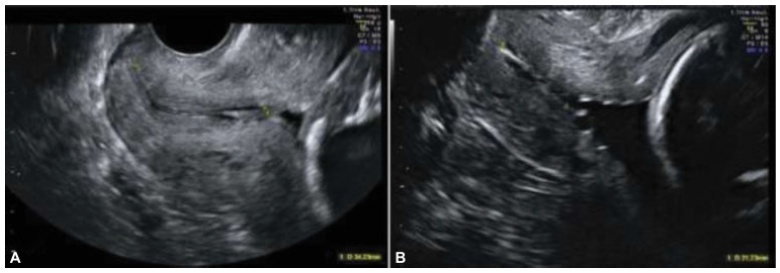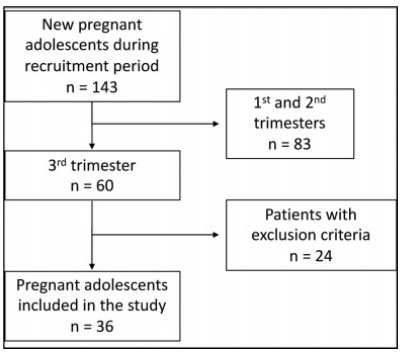Summary
Revista Brasileira de Ginecologia e Obstetrícia. 2021;43(6):436-441
The aim of the present study was to evaluate the risk factors for cesarean section (C-section) in low-risk multiparous women with a history of vaginal birth.
The present retrospective study included low-risk multiparous women with a history of vaginal birth who gave birth at between 37 and 42 gestational weeks. The subjects were divided into 2 groups according to the mode of delivery, as C-section Group and vaginal delivery Group. Risk factors for C-section such as demographic characteristics, ultrasonographic measurements, smoking, weight gain during pregnancy (WGDP), interval time between prior birth, history of macrosomic birth, and cervical dilatation at the admission to the hospital were obtained fromthe charts of the patients. Obstetric and neonatal outcomes were compared between groups.
The most common C-section indications were fetal distress and macrosomia (33.9% [n=77 and 20.7% [n=47] respectively). A bivariate correlation analysis demonstrated that mothers aged>30 years old (odds ratio [OR]: 2.09; 95% confidence interval [CI]: 1.30-3.34; p=0.002), parity >1 (OR: 1.81; 95%CI: 1.18-2.71; p=0.006), fetal abdominal circumference (FAC) measurement>360mm (OR: 34.20; 95%CI: 8.04 -145.56; p<0.001)) and<345mm (OR: 3.06; 95%CI: 1.88-5; p<0.001), presence of large for gestational age (LGA) fetus (OR: 5.09; 95%CI: 1.35-19.21; p=0.016), premature rupture of membranes (PROM) (OR: 1.52; 95%CI: 1-2.33; p=0.041), and cervical dilatation<5cm at admission (OR: 2.12; 95%CI: 1.34-3.34; p=0.001) were associated with the group requiring a C-section.
This is the first study evaluating the risk factors for C-section in low-risk multiparous women with a history of vaginal birth according to the Robson classification 3 and 4. Fetal distress and suspected fetal macrosomia constituted most of the Csection indications.
Summary
Revista Brasileira de Ginecologia e Obstetrícia. 2021;43(4):291-296
To evaluate whether continuation rates with the 52-mg levonorgestrelreleasing intrauterine system (LNG-IUS) up to 5 years after placement differed between women using the method exclusively for contraception and those using the device for medical reasons alone.
A retrospective cohort study was conducted in a family planning clinic with 5,034 LNG-IUS users: 4,287 using the method exclusively for contraception and 747 for medical reasons alone. The continuation rate at 1 to 5 years of use was calculated by life table analysis.
Initially, the continuation rate was significantly higher in the contraception group: 85.8 versus 83.4 and 77.4 versus 76.0 per 100 women-years in the 1st and 2nd years of use, respectively. There were more discontinuations due to bleeding/spotting in the medical reasons group in the first two years. The discontinuation rate according to reason for use was not significantly different from the third to the fifth year of use. No women discontinued due to amenorrhea in either group.
The continuation rate was significantly higher in the contraception group in the first two years of use. Amenorrhea was not a reason for discontinuation in either group, suggesting that counselling in this respect was adequate. Nevertheless, counselling could perhaps have been better with regards to the expected long period of bleeding and spotting in the first two years after placement.
Summary
Revista Brasileira de Ginecologia e Obstetrícia. 2021;43(4):283-290
Cesarean section (CS) delivery, especially without previous labor, is associated with worse neonatal respiratory outcomes. Some studies comparing neonatal outcomes between term infants exposed and not exposed to antenatal corticosteroids (ACS) before elective CS revealed that ACS appears to decrease the risk of respiratory distress syndrome (RDS), transient tachypnea of the neonate (TTN), admission to the neonatal intensive care unit (NICU), and the length of stay in the NICU.
The present retrospective cohort study aimed to compare neonatal outcomes in infants born trough term elective CS exposed and not exposed to ACS. Outcomes included neonatal morbidity at birth, neonatal respiratory morbidity, and general neonatal morbidity. Maternal demographic characteristics and obstetric data were analyzed as possible confounders.
A total of 334 newborns met the inclusion criteria. One third of the population study (n=129; 38.6%) received ACS. The present study found that the likelihood for RDS (odds ratio [OR]=1.250; 95% confidence interval [CI]: 0.454-3.442), transient TTN (OR=1.,623; 95%CI: 0.556-4.739), and NIUC admission (OR=2.155; 95%CI: 0.474-9.788) was higher in the ACS exposed group, although with no statistical significance. When adjusting for gestational age and arterial hypertension, the likelihood for RDS (OR=0,732; 95%CI: 0.240-2.232), TTN (OR=0.959; 95%CI: 0.297--3.091), and NIUC admission (OR=0,852; 95%CI: 0.161-4.520) become lower in the ACS exposed group.
Our findings highlight the known association between CS-related respiratory morbidity and gestational age, supporting recent guidelines that advocate postponing elective CSs until 39 weeks of gestational age.
Summary
Revista Brasileira de Ginecologia e Obstetrícia. 2021;43(4):275-282
Childbirth is a biological, psychological, and sociological event that can be a positive or negative experience, and, without support, this period may be potentially damaging. Parturition may distort maternal emotions and lead to short- or long-term disorders such as postpartum depression and anxiety. The present research aims to study the effects of dialectic behavioral therapy-based counseling on depression, anxiety symptoms, and postpartum hematocrit level.
The current research is a clinical trial study, and the sample was selected using parturients who were referred to the Health General Center with a diagnosis of postpartum depression and anxiety. The sample size consisted of 116 subjects who agreed to participate in the study. The patients in intervention group underwent group dialectic behavioral counseling (10 sessions/one session per week) and the control group did not receive any type of intervention. The patients were assessed in the first and last sessions as well as 2 months after the end of the sessions, using the Beck depression scale and Spielberg anxiety scale as well as the results of hematocrit tests. Data were analyzed using the IBMSPSS Statistics for Windows, Version 21.0 (IBMCorp., Armonk, NY, USA)
The results implied the effectiveness of dialectic behavioral therapy on reduction of the depression score, anxiety symptoms (p-value ≤ 0.0001), and hematocrit level (p-value=0.04). The participants’ depression, anxiety, and hematocrit levels decreased in the experiment group compared to the control group, and this decrease has remained until the 2-month follow-up.
It seems that dialectic behavioral counseling reduces the levels of postpartum depression, anxiety, and hematocrits.
Summary
Revista Brasileira de Ginecologia e Obstetrícia. 2021;43(4):264-274
To evaluate the applicability and usefulness of second-trimester TUCL to predict PTB in a cohort of Portuguese pregnant women.
Retrospective cross-sectional cohort study including all singleton pregnant women who performed their second-trimester ultrasound (between weeks 18 and 22þ6 days) from January 2013 to October 2017 at Centro Hospitalar Universitário São João.
Our cohort included 4,481 women. The prevalence of spontaneous PTB was of 4.0%, with 0.7% occurring before the 34th week of gestation. The mean TUCL was of 33.8mm,and percentiles 3, 5 and 10 corresponded toTUCLs of 25.0mm, 27.0mmand 29.0mmrespectively. The multiple logistic regression analysis, including maternal age, previous PTB and cervical surgery showed a significant negative association between TUCL and PTB, with an odds ratio (OR) of 0.92 (95% confidence interval [95%CI]: 0.90-0.95; p<0.001). The use of a TUCL of 20mm is the best cut-off, when compared with the 25-mm cut-off, improving the prediction of risk.
The present study showed an inverse association between TUCL and PTB, and that the inclusion of other risk factors like maternal age, previous PTB and cervical surgery can improve the screening algorithm. Furthermore, it emphasizes that the TUCL cut-off that defines short cervix can differ according to the population.

Summary
Revista Brasileira de Ginecologia e Obstetrícia. 2021;43(4):256-263
To investigate the association between prenatal care (PNC) adequacy indexes and the low birth weigth (LBW) outcome.
A total of 368,093 live term singleton births in the state of Rio de Janeiro (Brazil) from 2015 to 2016 were investigated using data from the Brazilian Live Birth Information System (Sistema de Informações sobre Nascidos Vivos, SINASC, in Portuguese). Seven PNC adequacy indexes were evaluated: four developed by Brazilian authors (Ciari Jr. et al., Coutinho et al., Takeda, and an index developed and used by the Brazilian Ministry of Health - MS) and three by authors from other countries (Kessner et al., the Adequacy of Prenatal Care Utilization index - APNCU, and the Graduated Prenatal Care Utilization Index - GINDEX). Adjusted odds ratios were estimated for the PNC adequacy indexes by means of multivariate logistic regression models using maternal, gestational and newborn characteristics as covariates.
When the PNC is classified as “inadequate”, the adjusted odds ratios to the LBWoutcome increase between 42% and 132%, depending on which adequacy index is evaluated. Younger (15 to 17 years old) and older (35 to 45 years old) mothers, those not married, of black or brown ethnicity, with low schooling (who did not finish Elementary School), primiparous, with preterm births, as well as female newborns had increasing odds for LBW. The models presented areas under the receiver operating characteristic (ROC) curve between 80.4% and 81.0%, and sensitivity and specificity that varied, respectively, between 57.7% and 58.6% and 94.3% and 94.5%.
Considering all PNC adequacy indexes evaluated, the APNCU had the best discriminatory power and the best ability to predict the LBW outcome.
Summary
Revista Brasileira de Ginecologia e Obstetrícia. 2021;43(6):429-435
To evaluate serum levels of adiponectin in pregnant adolescents between 30 and 36 weeks of gestation.
A prospective cross-sectional study enrolled 67 normal pregnant women between 30 and 36 weeks of gestation and eutrophic (body mass index [BMI]: 18.5-25 kg/m2), of which 36 were adolescents (< 20 years old) and 31 adults (≥ 20 years old). Serum adiponectin levels were determined by enzyme-linked immunosorbent assay (ELISA). The t-student or Mann-Whitney tests were used for intergroup comparison.
Pregnant adolescents showed significantly higher serum adiponectin concentrations comparedwith pregnant adults (p=0.04). No differences were observed in adiponectin levels in younger pregnant adolescents (< 16 years old) compared with older pregnant adolescents (≥ 16 years old). Adiponectin values were divided into 3 subgroups:<3,000 ng/mL, between 3,000 and 5,000 ng/mL, and>5,000 ng/mL. Birthweight was significantly higher in women>5,000 ng/mL when compared with<3,000 ng/mL in the adolescent group. No association between pregestational adiponectin levels and BMI, gestational weight gain, and gestational age was observed; however, there was a positive relation with birthweight (p=0.0239).
Serum adiponectin values in pregnant adolescents between 30 and 36 weeks of gestation were higher compared with pregnant adults; however, no differences between younger and older pregnant adolescents were observed.

Summary
Revista Brasileira de Ginecologia e Obstetrícia. 2021;43(3):200-206
Covid-19 became a pandemic, and researchers have not been able to establish a treatment algorithm. The pregnant population is also another concern for health care professionals. There are physiological changes related to pregnancy that result in different laboratory levels, radiological findings and disease progression. The goal of the present article is to determine whether the laboratory results and radiological findings were different in non-pregnant women (NPWs) of reproductive age and pregnant women (PWs) diagnosed with the Covid-19 infection.
Out of 34 patients, 15 (44.11%) PWs and 19 (55.8%) NPWs were included in the study. Age, comorbidities, complaints, vitals, respiratory rates, computed tomography (CT) findings and stages, as well as laboratory parameters, were recorded from the hospital database.
Themean age of the PWs was of 27.6 ± 0.99 years, and that of the NPWs was of 37.63 ± 2.00; when agewas compared between the groups, a statistically significant difference (p=0.001) was found. The mean systolic blood pressure of the PWs was of 116.53 ± 11.35, and that of the NPWs was of 125.53 ± 13.00, and their difference was statistically significant (p=0.05). The difference in the minimum respiratory rates of the patients was also statistically significant (p=0.05). The platelet levels observed among the PWs with Covid-19 were lower than those of the NPWs (185.40 ± 39.09 x 109/mcL and 232.00 ± 71.04 x 109/mcL respectively; p=0.05). The mean D-dimer value of the PWs was lower in comparison to that of the NPWs (p<0.05).
The laboratory findings and imaging studiesmay differ between pregnant and non-pregnant populations. It is important to properly interpret these studies. Future studies with a higher number of patients are required to confirm these preliminary data.
